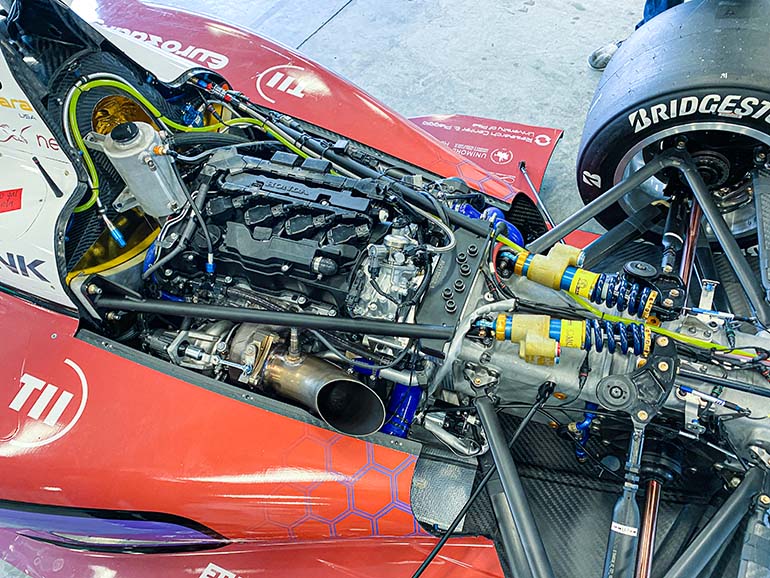|
Listen to this article
|

TUM wins the $1M prize at the 2021 Indy Autonomous Challenge. | Image credit: Mobile Robot Guide
TUM Autonomous Motorsport from the Technical University of Munich (TUM) won the Indy Autonomous Challenge (IAC), the first autonomous racecar competition at the Indianapolis Motor Speedway (IMS). TUM competed in a field of 9 teams from 21 universities to win the $1 million grand prize.
The Rules of the IAC competition required each team to compete in a fastest lap competition that included an obstacle avoidance component. TUM recorded the fastest 2-lap average speed of 135.944 on the famed IMS Oval.
“Participating in the Indy Autonomous Challenge allowed our team to advance autonomous driving technologies and being able to take first place after two years of hard work acknowledges that we had an outstanding team,” said Alex Wischnewski, team leader of TUM Autonomous Motorsport. “Our next goal is to win a high-speed autonomous head-to-head race.”
Here’s a video of the final timed race lap for TUM as they passed the stands and into turn 1:
I was fortunate to attend the event live at IMS, which lived up to its reputation as an incredible venue for an event like this. The event started with a Boston Dynamics Spot robot waving the checkered flag to start the competition.
The TUM team is made up of race fans who know the traditions of motor sports, including the tradition at IMS of “kissing the bricks” at the finish line.

Advancing the future of autonomous driving
Autonomous racing presents different challenges from autonomous driving on public streets. History was definitely made at the 2021 IAC event. Key to the challenge was the fact that all of the vehicles were identical in hardware design and build.
All of the cars shared the exact same chassis, engine and body design. The vehicles were all designed by Dallara and were similar to the Indy Lights vehicles. The race platform for this race was designated the Dallara AV-21. There was no advantage to any team in the physical vehicle design.

The powerplant, transmission and rear suspension of the Dallara AV-21 racecar. | Image credit: Mobile Robot Guide
Likewise, the racecars all shared the same autonomous driving technology, including LiDAR, RADAR, vision cameras, IMS and GPS sensor package. At the heart of the vehicles were top of the line Cisco routers (for routing all of the signals on-board) and an ADLINK Technologies AVA edge AI autonomous racing computer made just for IAC. (Stay tuned for a special race car tour with ADLINK’s CTO Joe Speed)
The cars all shared a similar software stack built on top of the ROS (Robot Operating System) with Eclipse Cyclone DDS. The most difficult problem to solve for IAC 2021 was to design the racing algorithms that allowed the sensor fusion and input processing to be done in real-time while the car was moving at high speeds. For example, at 135 MPH, the car is moving 66 yards per second or 2,376 inches per second. A lot has to happen in software to grab new data from all of the sensors and compute a new set point to steer the vehicle to the next trajectory setpoint on the racetrack.
While the cars didn’t need to worry about pedestrians and stop lights, they didn’t have much room for error with the race track’s barrier ever present. Several team’s vehicles crashed into the wall when the race cars became confused from the sensor inputs.
The race committee originally hoped that the teams could achieve a multi-car, head-to-head race. However, there just wasn’t enough testing time during the 2021 event to reach this goal. As a result, the race committee changed the rules for the final event on Saturday to be a time trial and obstacle avoidance contest. Each team had 2 laps to warm up the engine and tires, and then they were timed for two consecutive laps. The top three teams then went on to the finals, where it was 4 warm up laps and two timed consecutive laps.

A team member from Black and Gold Autonomous Racing team checks the car before starting it up. | Image credit: Mobile Robot Guide
In the end, three teams qualified for the finals. EuroRacing qualified first with an average speed of 131.148 mph; TUM qualified second with an average speed of 129.237 mph; Polimove qualified third with an average speed of 124.450. Kaist didn’t make the final cutoff, but still ran a speed of 84.355 mph. None of the other five teams were able to make it through their qualifying rounds. Three teams crashed their vehicles, and two teams didn’t make it out of the pits.
“The IAC would not be possible without the generous support of Lilly Endowment Inc. and the Indiana Economic Development Corporation, which have been committed partners since the beginning,” said Paul Mitchell. “The prize money won by TUM Autonomous Motorsport will go to the Technische Universität München (Technical University of Munich, Germany), to support the university’s efforts to further autonomous technology research and development. We know that the achievements of our IAC teams, alongside some of the best companies in the world, will certainly lead to the acceleration of Indiana’s AI and automation industries well into the future.”
In addition to thousands of attendees at the IMS, and more than 36,000 viewers on the AWS livestream, the IAC hosted 350 high school STEM students, the next generation of innovators, representing more than 50 urban, rural and suburban school districts across Indiana.







Tell Us What You Think!